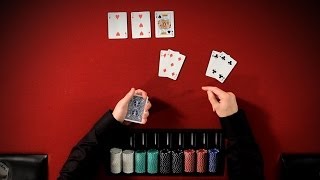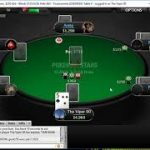Learn Texas Holdem Video Source & Info:
Like these Gambling Lessons !!! Check out the official app http://apple.co/1HCxrup
Watch more How to Play Poker videos: http://www.howcast.com/videos/515023-How-to-Calculate-Outs-Poker-Tutorials
Hey, I’m professional poker player Nicky Numbers, and today I’m going to talk to you about outs. An out is a term in poker that’s used to describe a card that you can hit that will improve your hand. Let’s dig right into it and look at some examples.
Let’s say you’re on a flop: deuce, three, king with two hearts. Depending on the hand you have, that will drastically affect how many outs you have. Let’s say we have five, six of diamonds. So we do not have a flush draw. However, if we hit a four, then we will make a straight: deuce, three, four, five, six. How many fours are there in the deck? Well, there are 4 fours in the deck, which means that we have four outs. There are 4 cards that can come that will improve our hand to one that we’re going to comfortably take to showdown. In this case a straight is a very strong hand. If we had four, five instead of five, six, then we would have what is known as an open-ended straight draw, which means we could hit one of 4 cards on the top of the straight and one of 4 cards on the bottom of the straight. In this case we have a draw of deuce, three, four, five, which means we can hit any one of the 4 sixes or any one of the 4 aces in the deck to make a straight. That contrasts drastically to the six, five which was just a gutshot straight draw and only had 4 outs. An open-ended straight draw has twice as many outs as a gutshot straight draw.
With ace, seven of hearts, we have a flush draw. There are 13 cards of any suit in the deck. Two of them are on the board, and 2 of them are in your hand. That means there’s only 9 hearts left in the deck, which is to say that there are 9 cards that can come that will give you a flush. In other words, you have 9 outs. With king, ten of hearts, it’s a very interesting hand because not only do you have hearts for a flush draw, but you also have a pair with king. A pair and a flush draw is a powerful combination draw. We have 9 hearts in the deck that can make us a flush. However, we also have 2 kings in the deck that can make us three of a kind as well as 3 tens in the deck which could make us 2 pair. So 9 hearts, plus 3 tens, plus 2 kings gives us 14 outs. Anytime you have 12 outs or more to make a strong hand, that’s an enormous amount of outs, and you should think of yourself as having a really strong holding. You should rarely fold on the flop if you flop 12 outs or more. Eight or 9 outs is a very solid draw, and that’s typically what people mean when they’re referring to a draw. However, the more outs you have, the more likely you are to win the hand. The more likely you are to win the hand, the less likely you should be to fold.
The last example here is four, five. Four, five of hearts has an open-ended straight draw as well as a flush draw. So there’s 9 outs to make a flush as well as 8 outs to make a straight. However, 2 of those outs that make a straight, the ace of hearts and the six of hearts, also make a flush, which means that those outs can’t be double counted. So instead of having 9 outs and 8 outs, we actually have 9 outs and 6 outs for a total of 15 outs. When you flop a straight draw and a flush draw with 15 outs, that’s a monster hand. In fact, when I go to bed at night and I dream about no-limit holdem, these are the kinds of flops that I see.
Source: YouTube








The problem with all of these "outs" is they don't factor in what the other players have or had an folded and the card peeled off between each street. For example, if all the example hands were hands held by actual players, the "Outs" would not exist in the deck.
Cant stand this guys voice.
good work nikki
So, where's the "calculations"? Counting outs is not calculating the odds or % of making a hand.
What about quads, i know it’s an extremely low possibility but you didn’t add that in.
deuce instead of two?
I refuse to calculate 'odds'. I can examine the deck ,the bet, what's in my hand and determine if it's worth it. Hold 'em is unpredictable you can make a educated judgment without the %.
Isn't this assuming you are the only player with a deck? If other players have one of the cards you would need for a straight for example you would only have 3 possible cards that would give you a straight
I learned how to go all in at a Asian massage parlor.
K so im Confused. Say i have AsQs and villain has 10h5h on a
Flop of: Kh 8h 3c
Villain has 15 cards in the deck To make a better hand then me and there are 45cards left in the deck. So villain has 15 outs right?
But if we look at it in the opposite way from my perspective, That would mean my outs are 45cards – 15villainouts= 30 cards in the deck out of 45 cards are Good for me. So you can basically say I have 30 outs on the turn and if the turn ends up one of my 30 outs, then on the river with 44 cards left i have 29 outs vs his 15 outs.
So from flop to turn: 30 cards good for me vs 15 cards (outs for villain) with 45 cards left to come
Turn to river if Turn was my out we subtract that out card ( for simplicity purposes it wasnt an ace or queen, so villain still has 15 outs): 29 cards vs 15 cards with 44 cards left.
How am I not the statistical advantage here since I have essentially 2 times More outs then my villans 15 outs…. 2to1 for turn and 1.9to1 on the river. I know i dont need outs since Im ahead but 30 cards are good for me 15 cards are good for the villain so i have double the outs for the turn and nearly ~ double the outs on the river….
So am i not 66% favorite 2/3 times i win and 1/3 times i lose?
2 to 1 means –> 2 times out of 3 i win so i am winning here 66% of the time.
How can he be essentially a 50/50 flip when i have 30 outs and he has 15 outs..